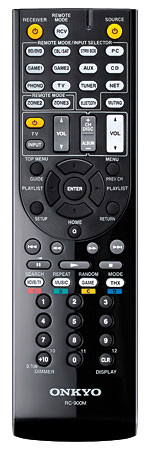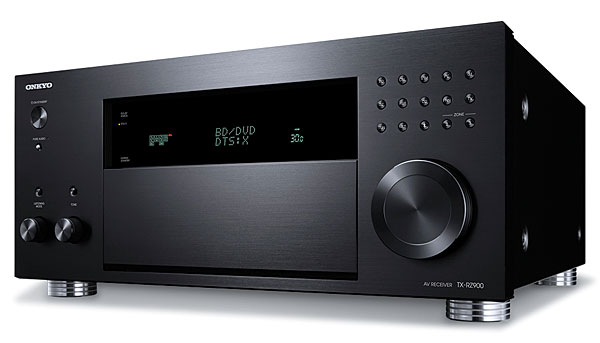Onkyo TX-RZ900 A/V Receiver Review Page 2
 The Hands-On
The Hands-On
Aside from its new front panel layout, the TXRZ900 is operationally similar to the last Onkyo receiver I reviewed, more than a year past. The supplied preprogrammed remote controller is virtually the same handset—logically laid out and reasonably readable, at least for the primary, on-key graphics. There’s no illumination, though, and you have to return the remote to receiver mode every time you change inputs; otherwise, the newly selected component will respond (if programmed), but the TX-RZ900 won’t. Onkyo’s handy pop-up adjustments menu is retained, but its name has been rationalized, avoiding the confusion between Setup and Home menus I observed on earlier iterations.
The new model incorporates fundamentally the same network music features as previous Net-ready Onkyos: Internet radio courtesy of TuneIn free radio streaming, plus Pandora, Spotify, Slacker, Deezer, and Sirius/XM subscription services. The TX-RZ900 streamed my music library via my desktop’s TwonkyMedia DLNA server, including hi-res FLAC, ALAC, and WAV formats, with all the expected sound quality, and with quicker, more responsive search and access times than I remember from previous models. However, even after updating the receiver to the latest firmware, the TX-RZ900’s network streaming interface wouldn’t accept DSD files for me (or even display all of them in their parent folers). This, despite Onkyo’s cut-sheet claims that it should have, up to DSD 5.6. An upgrade to the latest version of Twonky (8.2) didn’t resolve this, while the same DSD files all streamed and played just fine via my Oppo BDP-105 Blu-ray player’s network interface, which is connected via a standard Ethernet switch on the same network to which the Onkyo was connected. Similarly, I could not get DSD files to play from a USB thumb drive, though Onkyo’s manual says that the unit won’t do higher than DSD 2.8 from USB in any event.
The TX-RZ900’s built-in Wi-Fi connection found my 2.4-gigahertz network without issue and worked with no noticeable sacrifice in speed. I also confirmed the Onkyo’s Bluetooth and Apple AirPlay capabilities: Both operated without drama, and the receiver automatically selects its Net input in response to an AirPlay or Bluetooth handshake—pretty cool.
Onkyo headlines the TX-RZ900’s power supply with a newly engineered, large, high-current toroidal power transformer, and indeed, audio performance itself was just about faultless. The receiver displayed ample power to drive my mixed, medium-sensitivity loudspeaker suite to reference level in my 3,000-ish-cubic-foot studio, even without active subwoofer support. And while most receivers I’ve tried that are rated for 100 watts or more can claim the same, the new Onkyo seemed to have a larger margin of headroom (even at a decibel or two above reference level) than some, as well as a pleasingly authoritative, effortless quality on demanding stereo music, whether full-orchestra fortissimos or R&B horn sections.
Thus, at my preferred listening level a few decibels below reference, all was completely pristine. A hi-res recording like Stravinsky’s Suite from L’histoire du soldat, from an HDtracks 96/24 download, delivered all the transient crispness, textural complexity, and dynamic conviction I expect from recordings of this caliber. Of particular note were the arrestingly lifelike presence of the declamatory voice and the clarion timbre and pristine attack of the trumpet. (This excellent reading by Die Deutsche Kammerphilharmonie Bremen enjoys a fine recording indeed—the first I’ve heard to challenge my superb late-1960s Nonesuch LP, produced and engineered by the peerless duo of Marc Aubort and the late Joanna Nickrenz.)

Just as engagingly, the TX-RZ900 gave me an excuse to peruse a few new Atmos-equipped Blu-ray titles, if only via a 5.1.2 layout (with just two height speakers, in front). Like bay leaf in a stew, a little Tom Cruise goes a long way; still, the wow-factor of Mission Impossible: Rogue Nation is a course that’s hard to skip. You could pick any scene at random, really, but chapter 4—at the Vienna Opera, with chase, banter, and gunplay all interwoven with Turandot—did a great job of demonstrating the big Onkyo’s prowess with music, effects, and dialogue, all in the space of a few minutes. Atmos announces itself right from Puccini’s famous opening five chords, with the vertical space of the grand opera house well represented, followed by a great up, down, and all around workout in the chase through the backstage fly loft. Throughout this disc and several others, the TX-RZ900 never failed to deliver ample clean dynamics on even the biggest, full-frequency action.
In short, I have no bones to pick with the TX-RZ900’s A/V performance: It’s flagship-class, soup to nuts. Nor do I mean to pick on the new Onkyo in particular; as I said at the outset, the value proposition for top-of-the-line components is often problematic. The TX-RZ900 is expensive, yes, but it does all the basics we require from an A/V receiver very, very well, abetted by the full complement of up-to-the-minute technologies and features (albeit with the few limitations noted) and driven by playback power and quality that should satisfy the most demanding among us.





























































